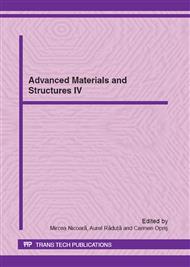[1]
W. Hufenbach, M. Krahl, Automotive lightweight seat structure with textile reinforced thermoplastic composites, 5th annual conference Innovative Seating, 08-10 February 2010, Frankfurt (Germany).
Google Scholar
[2]
A. Ruegg, S. Ziegler, D. Jaggi, N. Stotzner, Smart fourtwo tailgate: the first high-volume application of E-LFT technology, Jec Composites Magazine 45 (2008) 35–39.
Google Scholar
[3]
K. Rugg, B. Cox, K. Ward, G. Sherrick, Damage mechanisms for angled through-thickness rod reinforcement in carbon-epoxy laminates, Composites Part A: Applied Science andManufacturing 29 (1998) 1603–1613.
DOI: 10.1016/s1359-835x(98)00087-6
Google Scholar
[4]
B. Kolesnikov, L. Herbeck, A. Fink, Fortschrittliche Verbindungstechniken von Faser-verbundstrukturen, Deutscher Luft- und Raumfahrtkongress 2004, 20.-23. September 2004, p.9.
Google Scholar
[5]
P. Chang, A. P. Mouritz, B. N. Cox, Properties and failure mechanisms of pinned composite lap joints in monotonic and cyclic tension, Comp. Sci. Techn. 66 (2006) 2163–2176.
DOI: 10.1016/j.compscitech.2005.11.039
Google Scholar
[6]
I. K. Partridge, D. D. Cartié, Delamination resistant laminates by Z-Fiber pinning: Part I manufacture and fracture performance, Comp. Part A: Applied Science and Manufacturing 36 (2005) 55–64.
DOI: 10.1016/s1359-835x(04)00180-0
Google Scholar
[7]
D. Cartié, M. Troulis, I. Partridge, Delamination of Z-pinned carbon fibre reinforced laminates, Composites Science and Technology 66 (2006) 855–861.
DOI: 10.1016/j.compscitech.2004.12.018
Google Scholar
[8]
A. P. Mouritz, Review of z-pinned composite laminates, Composites Part A: Applied Science and Manufacturing 38 (2007) 2383–2397.
DOI: 10.1016/j.compositesa.2007.08.016
Google Scholar
[9]
A. P. Mouritz, P. Chang, H. Kong, Tensile Properties of Z-Pinned Polymer Composite Laminates, in: SAMPE Europe Int. Conference, 27-29 March 2006, Volume C, Paris, p.371–376.
Google Scholar
[10]
G. Freitas, C. Magee, P. Dardzinski, T. Fusco, Fiber Insertion Process for Improved Damage Tolerance in Aircraft Laminates, Journal of Advanced Materials 25 (1994) 36–43.
Google Scholar
[11]
C. Reis, D. Reis, Z-fiber pinning tool, International Patent (1999) 1–20.
Google Scholar
[12]
R. Olds, C. Feeney, Apparatus and method for providing reinforcement in a composite preform, International Patent (2000) 1–18.
Google Scholar
[13]
D. W. Johnson, S. A. Garrett, S. G. Moyers, J. M. Hook, Method of inserting z-axis reinforcing fibers into a composite laminate, International Patent (2003) 1–18.
Google Scholar
[14]
M. Heinzler, R. Kilgus, F. Näher, H. Paetzold, W. Röhrer, K. Schilling, Tabellenbuch Metall, Verlag Europa-Lehrmittel, Haan-Gruiten, 37 edition, 1990.
Google Scholar
[15]
C. Steeves, N. Fleck, In-plane properties of composite laminates with through-thickness pin reinforcement, International Journal of Solids and Structures 43 (2006) 3197–3212.
DOI: 10.1016/j.ijsolstr.2005.05.017
Google Scholar
[16]
W. Hufenbach, N. Modler, A. Winkler, R. Kupfer, Untersuchungen zur Charakterisierung des gradierten Faseranteils im Randbereich warmgeformter Löcher in textilverstärkten Thermoplastbauteilen, in: Tagung "Werkstoffprüfung 2010", 02. und 03. Dezember 2010, Verlag Stahleisen GmbH, Düsseldorf, Neu-Ulm, 2010, p.311–316.
Google Scholar
[17]
R. Lahr, Partielles Thermoformen endlosfaserverstärkter Thermoplaste, Ph.D. thesis, Technische Universität Kaiserslautern, 2007.
Google Scholar
[18]
N.N., Standard Test Method for Strength Properties of Double Lap Shear Adhesive Joints by Tension Loading (ASTM Standard D 3528), 1996.
DOI: 10.1520/d3528-96
Google Scholar
[19]
J. Wiedemann, Leichtbau - Elemente und Konstruktion, Springer-Verlag, Berlin Heidelberg, 3. Ausgabe, 2007.
Google Scholar
[20]
N.N., Product Information Twintex(R) T PP, Owens Corning Composite Materials LLC, Toledo, 2009.
Google Scholar


